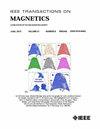3-D FE Analysis of Magnet Segmentation for Optimizing Thrust Force and Eddy Current Loss of Arc Linear Servo Motor
IF 2.1
3区 工程技术
Q3 ENGINEERING, ELECTRICAL & ELECTRONIC
引用次数: 0
Abstract
When employing high-magnetic co-energy sintered NdFeB magnets, permanent magnet linear synchronous machines (PMLSMs) exhibit several advantages over traditional induction and direct current machines, including greater thrust capability and efficiency. However, during operation at high frequencies, significant eddy current losses in the permanent magnet (PM) can result in elevated temperatures, increasing the risk of irreversible demagnetization. This issue is further compounded by the large air gap in such machines, making the thrust force a critical factor for ensuring efficient performance. A complete magnet segmentation (CMS) can be an effective method for reducing the PM eddy current losses, but it reduces the thrust characteristics and mechanical robustness of the PMLSM. Therefore, a partial magnet segmentation (PMS), namely, single-side PMS (SSPMS), is studied for the new arc-structured PMLSM to optimize the eddy current loss and thrust force. A comparison between the initial PM, CMS, and SSPMS is performed using the Ansys Maxwell 3-D finite element analysis (FEA) tool. The results demonstrate that the SSPMS configuration significantly reduces PM eddy current loss while maintaining the same thrust force. Moreover, it offers superior mechanical robustness and lower manufacturing costs compared to the conventional CMS.用于优化电弧直线伺服电机推力和涡流损耗的磁体分割三维有限元分析
当采用高磁共能烧结钕铁硼磁体时,永磁直线同步电机(PMLSMs)比传统的感应和直流电机具有几个优势,包括更大的推力能力和效率。然而,在高频工作期间,永磁体(PM)中显著的涡流损耗会导致温度升高,增加不可逆退磁的风险。这种机器的大气隙使这个问题进一步复杂化,使推力成为确保高效性能的关键因素。完全磁体分割(CMS)是减小永磁同步电机涡流损耗的有效方法,但它会降低永磁同步电机的推力特性和机械鲁棒性。为此,研究了一种局部磁体分割(PMS)方法,即单侧磁体分割(SSPMS),以优化新型电弧结构永磁同步电机的涡流损耗和推力。使用Ansys Maxwell三维有限元分析(FEA)工具对初始PM、CMS和SSPMS进行了比较。结果表明,在保持推力不变的情况下,SSPMS结构显著降低了PM涡流损失。此外,与传统CMS相比,它具有优越的机械稳健性和更低的制造成本。
本文章由计算机程序翻译,如有差异,请以英文原文为准。
求助全文
约1分钟内获得全文
求助全文
来源期刊

IEEE Transactions on Magnetics
工程技术-工程:电子与电气
CiteScore
4.00
自引率
14.30%
发文量
565
审稿时长
4.1 months
期刊介绍:
Science and technology related to the basic physics and engineering of magnetism, magnetic materials, applied magnetics, magnetic devices, and magnetic data storage. The IEEE Transactions on Magnetics publishes scholarly articles of archival value as well as tutorial expositions and critical reviews of classical subjects and topics of current interest.
 求助内容:
求助内容: 应助结果提醒方式:
应助结果提醒方式:


